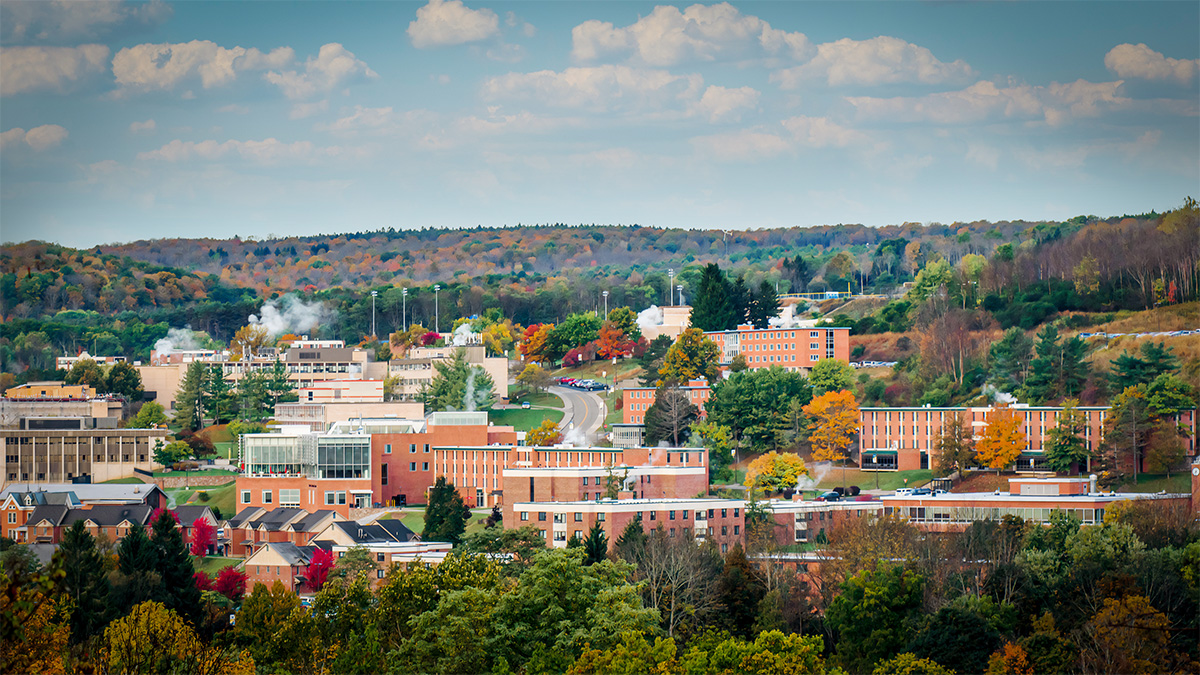
At a glance
Alfred State’s March 20 New Horizons Forum will feature , assistant professor, Building Trades, presenting an account of his work on an international team to re-create sections of the 17th century Gwozdziec Synagogue in Poland during the summer of 2011. The presentation will be held at 6:30 p.m. on Tuesday, March 20 in room 215 of the Engineering Technology (SET) building on the Alfred campus.

Alfred State’s March 20 New Horizons Forum will feature Leon Buckwalter, assistant professor, Building Trades, presenting an account of his work on an international team to re-create sections of the 17th century Gwozdziec Synagogue in Poland during the summer of 2011. The presentation will be held at 6:30 p.m. on Tuesday, March 20 in room 215 of the Engineering Technology (SET) building on the Alfred campus. All are welcome to a reception immediately preceding the presentation.
Leon was selected for a 22-member international team to build a replica of the Gwoździec Synagogue timber frame roof structure and the vaulted ceiling for permanent exhibition at the Museum of the History of Polish Jews in Warsaw, Poland as the first major element of its core exhibition.
Leon initially went to Poland in 2003, again as part of an international team, to investigate the feasibility of the project, and, since the Nazis burned all the wooden synagogues in Poland, to look at churches of other faiths of the same time frame to get clues to tools and techniques used by builders of the time.
Team members created an 85% scale replica of the timber roof structure from the now lost 17th century wooden Gwoździec Synagogue. The project includes the very ornate duplication of the painting of the interior of the roof dome, which will take 18 months to complete. All of the nearly two-hundred 17th and 18th century wooden synagogues built throughout the Polish Lithuanian Commonwealth were destroyed by the end of World War II, yet the vernacular wooden architectural styles - both aesthetically and structurally – are still apparent in many other existing wooden structures in Poland.
Scheduled to open in 2012, the Museum of the History of Polish Jews will present the 1,000-year history of Polish Jews and the civilization that they created. Understandably, the Shoah and the void that it has left have overshadowed this story. By presenting the civilization that Jews created in the very place where they created it, the Museum will convey the enormity of what was lost. Standing on the site of the former Warsaw Ghetto, the Museum of the History of Polish Jews will honor those who died by remembering how they lived.
The Museum, the first public-private partnership of its type in Poland and joint effort of the Association of the Jewish Historical Institute of Poland, the Government of Poland, and the City of Warsaw, will fulfill its educational mission not only through its Core Exhibition, but also through it Educational Centre, public programs, and facilities, including a resource center, mediateque, large auditorium, two cinematheques, rooms for conferences and workshops, and galleries for temporary and traveling exhibitions. Total space is about 12.000 m2, including 4.000 m2 for the Core Exhibition. In the Museum’s multi-media narrative exhibition, which is more a “theatre of history” than a conventional exhibition of objects, visitors will discover the vibrancy of what was once the largest Jewish community in the world and center of the Jewish Diaspora. The single most spectacular element in the Core Exhibition will be the Gwozdiec wooden synagogue ceiling and roof.
Handshouse Studio, through which this program is offered, is a not-for-profit, innovative, educational organization that creates adventurous hands-on projects through community-service, building projects with non-profit partners around the world and is a Cooperating Institute with the Massachusetts College of Art and Design Professional and Continuing Education Program. Handshouse creates projects outside of the traditional classroom that energize history through the reconstruction of large historical objects.
Leon’s career has centered around building things; his experiences led to an interest in timber framing and an offshoot of his contracting business, called Ischua Valley Timber Frames. Along with this came membership in an approximately 2,000-member world-wide organization called the Timber Framers Guild, then a seat on its Board of Directors, and eventually vice presidency of the Guild.
Leon pursued historic log and/or timber frame projects, which generally had connections to people, places, and events of long ago. An interest in and collection of antique wood-working tools led to investigation of how those tools were used by yesterday’s master craftsmen. Gaining proficiency with those tools has opened doors to projects where the end product, or structure built, is sometimes no more important than demonstrating and passing along the skills, knowledge, and techniques of our forefathers.
In 1993, Leon participated in a Timber Framers’ Guild-sponsored trip to St. Petersburg, Russia, where he assisted in building a timber-framed addition to a wooden-boat-building school.
Additionally, Leon has participated in USDA Forest Service-funded research, resulting in "The Effects of Time on the Longevity of the Linn Run Bridges" paper. He has also published and presented throughout the Northeast.
In addition to his affiliation with the Timber Framers’ Guild, Leon is also a member of the boards of the NYS Barn Coalition and the Preservation Trades Network.
In 2001, Leon was hired at Alfred State to develop and teach courses in historic preservation and timber framing. He remains active in the Timber Framers Guild and the Traditional Timber Frame Research and Advisory Group. He holds a degree in construction engineering technology from Alfred State.
